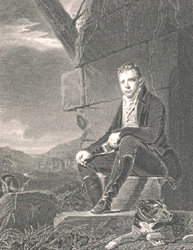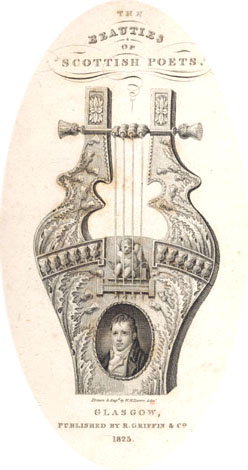|
|
Home | Corson
Collection | Biography | Works | Image
Collection | Recent
Publications | Correspondence | Forthcoming
Events | Links | E-texts | Contact
Sir Henry Raeburn's 1808 Portrait of Sir
Walter Scott
 In
1808, Scott's publisher Archibald Constable, delighted by the unprecedented
success of Scott's second narrative poem Marmion,
commissioned a portrait from Sir
Henry Raeburn. Unlike the earlier
portraits of Scott which were designed for a private, domestic
setting, Raeburn's
portrait was very much conceived with reproduction in mind. For
over a decade, it would be the most frequently engraved and widely
diffused image of Scott. It proved immensely influential not only
in framing Scott in the public's mind-eye but in creating a prototype
for Romantic portraiture. Here for the first time Scott is explicitly
personified as a poet in a setting imbued with allusions to his
own work. He is portrayed deep in thought, with a notebook in one
hand and a pen in the other. He sits on a fallen stone before a
ruined medieval tower with his favourite dog Camp at
his feet. In the background may be seen the hills of Liddesdale
and Hermitage Castle, which are featured both in Marmion and Minstrelsy
of the Scottish Border. Click on the thumbnail to the
right to see an engraving of Raeburn's 1808 portrait made by John
Horsburgh. In
1808, Scott's publisher Archibald Constable, delighted by the unprecedented
success of Scott's second narrative poem Marmion,
commissioned a portrait from Sir
Henry Raeburn. Unlike the earlier
portraits of Scott which were designed for a private, domestic
setting, Raeburn's
portrait was very much conceived with reproduction in mind. For
over a decade, it would be the most frequently engraved and widely
diffused image of Scott. It proved immensely influential not only
in framing Scott in the public's mind-eye but in creating a prototype
for Romantic portraiture. Here for the first time Scott is explicitly
personified as a poet in a setting imbued with allusions to his
own work. He is portrayed deep in thought, with a notebook in one
hand and a pen in the other. He sits on a fallen stone before a
ruined medieval tower with his favourite dog Camp at
his feet. In the background may be seen the hills of Liddesdale
and Hermitage Castle, which are featured both in Marmion and Minstrelsy
of the Scottish Border. Click on the thumbnail to the
right to see an engraving of Raeburn's 1808 portrait made by John
Horsburgh.
When exhibited in Edinburgh in 1809, the Scots Magazine judged
it 'an admirable painting, with most appropriate scenery'. The Repository
of Arts, however, wrote that: 'This last of the minstrels
shows how lamentably the race is degenerated, for never was a more
unpoetical physiognomy delineated on canvas; we might take him
for an auctioneer or a land-surveyor, a travelling dealer or chapman:
in short for any character but a bard' (III, 18:VI:1810, p. 36).
Scott's friend J.S. Morritt considered it 'a most faithful likeness'.
Scott's expression was 'serious and contemplative, very unlike
the hilarity and vivacity then habitual to his speaking face, but
quite true to what it was in the absence of such excitement'. However,
Morritt felt that Raeburn had failed to convey the 'flashes of
the mind within' which 'almost always lighted up' features that
might otherwise appear 'commonplace and heavy' (quoted in Lockhart, Life,
2nd ed., III, 99-100).
Scott himself shared Morritt's view that in
aiming for solemnity Raeburn had given him a somewhat stolid
air. His features are softened in an alternative version
painted for Scott himself by Raeburn in 1809. Eventually,
though, Scott appears to have been reconciled to the 1808
portrait. When Archibald Constable was bankrupted in 1826
(see The Fall
of Archibald Constable and Co.), the painting was purchased
by Scott's patron the 5th Duke of Buccleuch. In a letter
to the Duke of 14 December 1826, Scott wrote: 'I must say
I was extremely gratified by seeing Raeburns portrait (which
was like what the original was some two or three years before
your Grace was born) hanging at Dalkeith and feel sincerely
the kindness which placed it there. One does not like the
idea of being knockd down even though it is only in effigy'
(Letters, X, 139-40). Today the painting still hangs
at Bowhill, home of the Dukes of Buccleuch.
Many published engravings were made after Raeburn's 1808
portrait. In his Portraits of Sir Walter Scott,
Francis Russell lists 6 engravings of the complete portrait
and 14 derivations including partial reproductions and
variations on Raeburn's original. A mark of the ubiquity
and recognisability of the image is its incorporation into
the lyre on the title-page of the 1823 anthology The
Beauties of Scottish Poets, Ancient and Modern (see
right).
|
|
Click the links below to view a selection
from Edinburgh University Library's Corson
Collection.
Reproductions
|
Derivations
|
Bibliography
- Dictionary of National Biography (London:
Oxford University Press, 1921)
- Johnson, Edgar. Sir Walter Scott:
The Great Unknown (London: Hamish Hamilton, 1970)
- Lockhart, John Gibson. Memoirs of
the Life of Sir Walter Scott, Bart. (Edinburgh: R. Cadell,
1837-38)
- Russell, Francis. Portraits
of Sir Walter Scott: A Study of Romantic Portraiture (London:
The Author, 1987)
- Scott, Walter, Sir. The Journal of Sir Walter Scott,
Bart., ed. W.E.K. Anderson (Oxford: Clarendon Press, 1972)
- Scott, Walter, Sir. The
Letters of Sir Walter Scott, ed. H.J.C. Grierson (London:
Constable, 1932-37)

Last updated: 14-Mar-2005
© Edinburgh University Library
|
|



